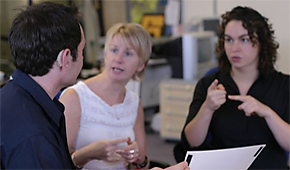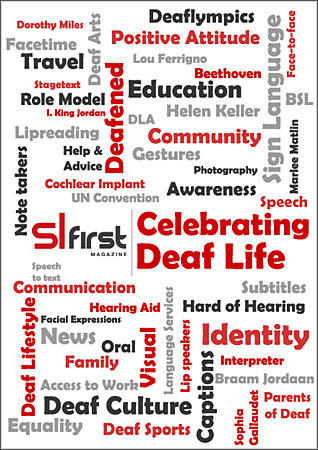Captioned & Signed4th May 2015
Hap & Stace Launch Sign-Song YouTube channel
Seeing a rise in 'BSL' signed songs, I wanted to find out about the underlying motivation

I must confess I have not been the greatest lover of signed songs in the past. Generally, they portray themselves as being American (ASL) or British (BSL) sign language songs, but in reality they use signs in sequence with the English words, making it more SSE (Sign Support English) than a formal sign language. Whilst cultural Deaf BSL users will know that, as a teacher of BSL, I always worried that hearing viewers and BSL learners would think that is the way ASL or BSL works - a strict translation of individual words, instead of the translation of meaning which is how sign language actually works.
 As I don’t hear the music and can only see the signed translation, I think that limits the affect on me compared to a hearing audience. However, I remember well the performance that made me look at signed performance differently, it was a stunning signed interpretation of the American National Anthem by Deaf actress Amber Zion, and it was through that performance that I came to accept that signed performances were works of art, not an attempt at strict sign language translation of the song. I certainly hope that is the thinking of the people performing them anyway.
As I don’t hear the music and can only see the signed translation, I think that limits the affect on me compared to a hearing audience. However, I remember well the performance that made me look at signed performance differently, it was a stunning signed interpretation of the American National Anthem by Deaf actress Amber Zion, and it was through that performance that I came to accept that signed performances were works of art, not an attempt at strict sign language translation of the song. I certainly hope that is the thinking of the people performing them anyway.
What we have seen in recent years is a rise in signed songs with some of them becoming very popular, attracting millions of views. There have been more in the United States, many of them done by Deaf youngsters using American Sign Language, and we are now seeing a rise in Britain, usually with interpreters and hearing people who can sign doing their signed interpretation of songs.
Coming across one such performance performed by Hap & Stace on YouTube a few weeks ago, I thought it was fun and performed as a duo, I thought it was quite beautifully done. Knowing nothing about the two ladies performing, I decided to find out more.
 The performers Stacey Stockwell and Lian Duan (nicknamed Haplocke) are from America and China respectively. Stacey has been signing for 19 years having had the chance to start learning BSL when she was working for a large IT company when she was 26 years old. Enjoying it from the start, Stacey has gone on to achieve her Level 6 four years ago, then becoming a Trainee Interpreter and starting her RSLI. Quitting the programme because it required far too much work involved in putting together the portfolio.
The performers Stacey Stockwell and Lian Duan (nicknamed Haplocke) are from America and China respectively. Stacey has been signing for 19 years having had the chance to start learning BSL when she was working for a large IT company when she was 26 years old. Enjoying it from the start, Stacey has gone on to achieve her Level 6 four years ago, then becoming a Trainee Interpreter and starting her RSLI. Quitting the programme because it required far too much work involved in putting together the portfolio.
Now 30, Lian’s interest in BSL came when she saw a tiny advert in a newsletter from her brother’s school. Achieving her Level 2 she than had a 7-year break before restarted 6 years ago, and is now studying for her Level 6.
With a background in music Stacey taught singing, piano and the Theory of Music for several years whilst also being the Lead Alto for the National Youth Choir of Great Britain. She was also one of the first people in the UK to start a karaoke business. Through learning BSL, Stacey set up her own training company with her partner 15 years ago. She now teaches Disability Awareness.
 Lian, or Hap as she is more commonly known schooled in Reading, after which she travelled around the UK for a few years. She has become passionate about BSL as well as social justice, which means she is often involved in political issues, with a particular interest in the dynamic between the Deaf and hearing worlds.
Lian, or Hap as she is more commonly known schooled in Reading, after which she travelled around the UK for a few years. She has become passionate about BSL as well as social justice, which means she is often involved in political issues, with a particular interest in the dynamic between the Deaf and hearing worlds.
“We met each other 15 years ago when Hap came to my sign language class,” Stacey told me. “I am very proud to say I was her first Sign Language teacher!”
So, what about the Hap and Stace YouTube channel and signed songs. Where did that idea come from from? “It came from our good friends Tea Smart and Elizabeth Marshall who own a filming company,” Stacey explained. “Although they don’t sign, they love watching sign songs and pointed out that there are far more songs available on the internet in ASL than BSL, so they asked if we would like to join forces with them and set up a new channel.”
Hap went on to say, “Stacey’s passion for sign song really rubbed off on me, and I never forgot her signing ‘Belleau Wood’ by Garth Brooks. I used to try and emulate her while I was learning, and having a passion for really exploring expressive means of communication got me hooked on sign songs. We know we work well together, so we were thrilled when Tea and Liz came up with the idea of a YouTube channel.”
Stacey told me that they are doing these signed songs to bring to the fore a language that hearing people rarely see. “The majority of hearing people don’t realise that music and dance can still be an important part of life for many Deaf people, so this is a great way of raising awareness, which is one of our driving factors in our sign song performances.”
 Using colleagues from an interpreter and Deaf/disability awareness training company that they both work for, Hap and Stace seek advice from some of the interpreters and Deaf people who work there. Finding a mixture of viewpoints, especially from the Deaf staff, Hap and Stace perform trying to appeal to as wide an audience as possible with, “A mixture of BSL and SSE, along with expression and natural body language.”
Using colleagues from an interpreter and Deaf/disability awareness training company that they both work for, Hap and Stace seek advice from some of the interpreters and Deaf people who work there. Finding a mixture of viewpoints, especially from the Deaf staff, Hap and Stace perform trying to appeal to as wide an audience as possible with, “A mixture of BSL and SSE, along with expression and natural body language.”
A brand new project, Hap and Stace have recorded 8 songs so far, but not all of them have been released yet. Their plan is to release at least one new song a week.
Both Hap and Stace have done signed performances in the past, including between them, signing at local theatre groups, festivals, arts events, LFest and at Pride events. They are booked to sign at the Hexagon Theatre in Reading in July for a sing-a-long production of ‘Frozen’ which explains where the signed performance of that song came from on their YouTube channel.
With plans to do a range of signed songs in the future, Hap and Stace have a different taste in music and their film production partners in this venture have identified the success of signing chart topping tracks that are proving so popular amongst a hearing audience at the moment, so they intend to do a range of performances that suit different tastes in music.
For now, they are just enjoying the venture and feeling their way around whilst they await feedback.
Both Hap and Stace tell me how much they enjoy BSL, with Stacey in particular believing that it is not the only important part of communication between Deaf and hearing people, with “SSE, expression, natural body language and effective communication all extremely important when it comes to interacting with each other.” Appearing on See Hear about 6 years ago, Stacey considers that she was, “Probably the only person brave enough in the UK to say that Deaf people should have Hearing Awareness training!!”, a viewpoint that she still holds strong opinions about today.
Watching their performances, you can tell that a lot of hard work has gone into them, none more so than their rendition of ‘Frozen Heart’. As Stacey explained, “I just had a mental block! Our other songs were recorded in 1 or 2 takes, and yet I simply could NOT get through that track without going wrong somewhere or signing something completely different from Hap. The track starts with a group of men, with very low voices, singing ‘BOOORRRRN’ which we ended up texting to each other at random times! I think we’ll all be very pleased if we never hear that track again!”
You can see the signed songs Hap & Stace have made available here: YouTube
Whilst I simply loved the cultural Deaf interpretated performance of Amber Zion, and I appreciate the time and effort Stacey and Lian have put into their performaces, I'm afraid 'signed songs' still don't work well for me. If Deaf people were involved in the actual performance and cultural deaf BSL played a part in the performaces with a translation of meaning rather then words, I may feel they are aimed more at me. For now, I am happy to accept that the majoroity of these videos are hearing people using the medium of BSL to perform to other hearing people, and if it does nothing more than raise awarness of BSL, then that is probably a worthwhile outcome.
Article by Sarah Lawrence, Editor
posted in Entertainment / Captioned & Signed
4th May 2015





